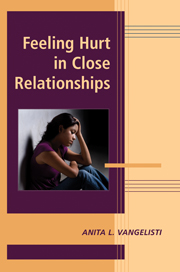Book contents
- Frontmatter
- Contents
- List of Contributors
- Foreword
- PART I INTRODUCTION
- PART II CONCEPTUALIZING HURT
- 2 The Nature of Hurt Feelings: Emotional Experience and Cognitive Appraisals
- 3 Thinking the Unthinkable: Cognitive Appraisals and Hurt Feelings
- 4 Adding Insult to Injury: The Contributions of Politeness Theory to Understanding Hurt Feelings in Close Relationships
- 5 Rejection Sensitivity: A Model of How Individual Difference Factors Affect the Experience of Hurt Feelings in Conflict and Support
- 6 Understanding and Altering Hurt Feelings: An Attachment-Theoretical Perspective on the Generation and Regulation of Emotions
- PART III HURTFUL ACTS
- PART IV HURT IN RELATIONAL CONTEXTS
- PART V HURT IN APPLIED CONTEXTS
- Author Index
- Subject Index
- References
6 - Understanding and Altering Hurt Feelings: An Attachment-Theoretical Perspective on the Generation and Regulation of Emotions
from PART II - CONCEPTUALIZING HURT
Published online by Cambridge University Press: 04 August 2010
- Frontmatter
- Contents
- List of Contributors
- Foreword
- PART I INTRODUCTION
- PART II CONCEPTUALIZING HURT
- 2 The Nature of Hurt Feelings: Emotional Experience and Cognitive Appraisals
- 3 Thinking the Unthinkable: Cognitive Appraisals and Hurt Feelings
- 4 Adding Insult to Injury: The Contributions of Politeness Theory to Understanding Hurt Feelings in Close Relationships
- 5 Rejection Sensitivity: A Model of How Individual Difference Factors Affect the Experience of Hurt Feelings in Conflict and Support
- 6 Understanding and Altering Hurt Feelings: An Attachment-Theoretical Perspective on the Generation and Regulation of Emotions
- PART III HURTFUL ACTS
- PART IV HURT IN RELATIONAL CONTEXTS
- PART V HURT IN APPLIED CONTEXTS
- Author Index
- Subject Index
- References
Summary
It is exciting to see how far research on hurt feelings has progressed since 1987 as both affective science and relationship science have blossomed. Our own professional involvement with the study of hurt feelings began accidentally, in the late 1980s, when Shaver, Schwartz, Kirson, and O'Connor (1987) probed the semantic structure of the English emotion lexicon, finding five major clusters of emotion terms in Americans' everyday vocabularies – clusters labeled love, joy, anger, sadness, and fear. Because of the prominence in the late 1980s of Ekman and Izard's discrete emotions theories (e.g., Ekman, 1992; Izard, 1977), Shaver et al. (1987) viewed particular members of each of the five emotion clusters as either prototypical of that cluster or as “blends” of two or more basic emotions. One such blend, according to the authors, was hurt
The emotion hurt, for example, although it appears within the sadness [category], seems to be a blend of sadness and anger.…A person feels hurt, according to subjects' accounts, when he or she has been wronged in a way that warrants anger (i.e., in a way that is unfair [or] inappropriate given agreed-upon roles or rules) but believes that the offender does not care enough to rectify matters, even if a reasonable objection were to be raised (cf. de Rivera, 1977). Not surprisingly, hurt is…mentioned more frequently by people who perceive themselves to be the weaker…party in a relationship.
(p. 1082)- Type
- Chapter
- Information
- Feeling Hurt in Close Relationships , pp. 92 - 120Publisher: Cambridge University PressPrint publication year: 2009
References
- 23
- Cited by

